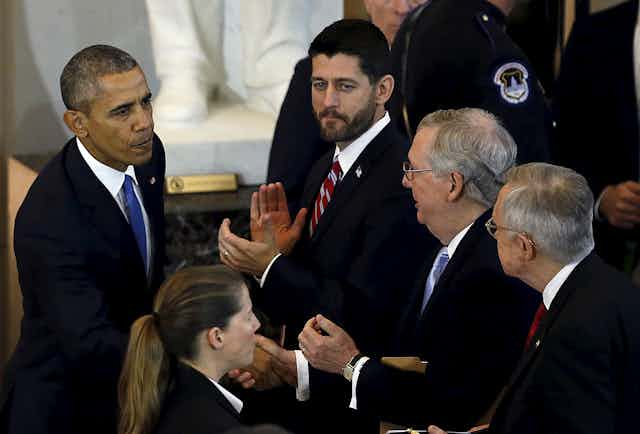Christmas came early for Congress this year as politicians from both sides of the aisle came together to pass – by wide margins – a US$1.8 trillion package of tax cuts and new spending.
At year end, Washington seemed awash in a spirit of holiday cooperation with the president praising new Speaker Paul Ryan. But does the bipartisan approval of the budget deal really mean that Democrats and Republicans have learned to play together nicely in the Congressional sandbox?
Definitely not.
This legislative package was adopted with little rancor because both parties agreed to lift existing caps on discretionary spending and to cut taxes without trying to raise offsetting revenues. So both sides got most of their desired list of Christmas presents – increases in defense and domestic spending plus expanded tax incentives for businesses and individuals.
The big losers were future taxpayers who will have to shoulder the burden of higher interest payments. As the size of the national debt balloons and the rate of interest gets back to normal levels, these payments will consume more of the annual budget and leave less room for spending on defense as well as domestic programs (except for entitlements such as Social Security and Medicare).
Even before this year-end legislation, the national debt was already huge relative to the size of the US economy. While declining annual budget deficits in the last few years have created the impression of fiscal responsibility, the U.S. national debt has more than doubled over the last decade.
Debt from sea to shining sea
In 2005, the U.S. national debt owed to public investors was $5 trillion, or 35% of GDP. By the end of 2015, this amount had risen to over $13 trillion, or 74% of GDP.
Yet this metric of national debt owed to public investors does NOT include over $5 trillion in intra-governmental debt – money that one part of the government owes another – owed to programs like Social Security. Thus, the total outstanding national debt is currently almost $19 trillion and growing steadily.
Despite the rising debt, however, Congress chose to extend and expand tax credits and deductions for businesses and individuals without trying to find offsetting revenues.
The largest tax breaks for business were making permanent the tax credit for research and a tax exemption that allows companies with “active financing” operations overseas to shield such financing income from US tax, while allowing many businesses to immediately expense their capital investments. The largest tax breaks for individuals included expanding credits for low-wage earners and extending deductions for local-state sales taxes.
As a result, the Joint Committee on Taxation estimated that these changes would cost $680 billion over the next ten years. If we tack on the extra interest incurred as a result, the price tag for the tax deal in terms of additional debt would rise to $830 billion over the next ten years.
Estimating the impact of new spending
The debt impact of the new spending is harder to estimate.
For fiscal year 2016, the total spending would be approximately $1.15 trillion. That spending level, together with lost tax revenue, implies a budget deficit above $500 billion for 2016, according to my estimates, compared with $439 billion last year. If Congress continues to disregard its own previous agreements on spending limits, the total increase in the national debt could easily exceed $5 trillion during the next decade.
Going forward, Congress cannot afford to continue to hand out tax benefits without offsetting revenues and to increase discretionary spending across the board. These practices will drive up the US government’s debt to levels that crowd out private borrowing and limit valuable social programs. This is my conclusion based on years of studying fiscal issues – starting when I was president of Fidelity Investments, then as a member of the President’s Commission to Strengthen Social Security under George W. Bush, and more recently while teaching at Harvard and MIT.
My conclusion is supported by the General Accounting Office (GAO), which estimated two long-term fiscal paths for the U.S.
Emphasizing that federal spending increases will be largely driven by an aging population with associated medical and retirement costs, the GAO warned that
a fundamental imbalance between revenues and spending over the long term would lead to continued growth in national debt as a share of GDP, and
a substantial increase in national debt as a share of GDP would limit the federal government’s flexibility to address future challenges driven by an aging population.
A disastrous outlook
The first set of estimates by the GAO were based on favorable assumptions – most of which were violated by the recent tax and spending legislation. For example, the GAO assumed that discretionary spending would remain at historically low levels, and that expiring tax breaks would not be extended.
Even under these favorable assumptions, the long-term fiscal outlook for the U.S. was disastrous.
Under the first scenario estimated by the GAO, national debt held by the public would exceed 100% of GDP in 2033. In that year, payments for Social Security, Medicare and Medicaid plus interest on the national debt would equal total federal revenues.
The results were worse in the second scenario when the GAO used assumptions that are more consistent with the measures adopted in the recent year-end legislation. Under the second scenario, the national debt held by the public would exceed 100% of GDP by 2027 or 2028, and payments for retirement and medical entitlements plus debt interest would equal federal revenues.
In short, Congress was lulled into complacency by two years of budget deficits under $500 billion, declining from $1.4 trillion in 2009.
Within a few years, however, the demographic forces in the U.S. will push our national debt above our GDP and threaten the funding of many important programs. So Congress should not repeat the sins underlying the recent display of bipartisanship.
In the future, Congress should not approve tax cuts without offsetting revenues or ignore existing caps on discretionary spending.

